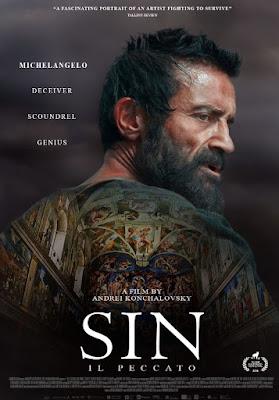
“Arrogance is sin”
“I wanted to find God; I only found Man”
“Money always rubs elbows with infamy”
--key lines spoken in Sin--co-scripted by Andrei Konchalovsky and Elena Kisaleva
Andrei Konchalovsky’s Sin is a film more on the thoughts of the amazingly gifted painter, sculptor and writer Michelangelo (1465-1564) and less on his famous works and how he created those masterpieces of art. The film presents a frenetic individual at the time of his life when he was sculpting night and day, more than he was painting or writing, often in imaginary conversation with the dead poet Dante Alighieri whose works he knew by rote, even while walking alone. The more we delve into Konchalovsky’s film Sin, one appreciates the dogged research that went into the making of the film to connect the dots between Dante’s The Divine Comedy, the historical battles between two rich Roman families--the Della Povere and the Medicis--to install Popes, and the effect of both Dante’s works and the two Roman families that controlled and influenced the creative outputs of Michelangelo, which included the final design of the existing St Peter’s Cathedral in Vatican City, apart from fresco paintings and sculptures admired to date. At a different level, the film is a perfect example of the importance of original co-scriptwriters—in this case, the gifted team of Konchalovsky and Elena Kiseleva-- in creating a feature film, than other facets, as is often perceived in good cinema.
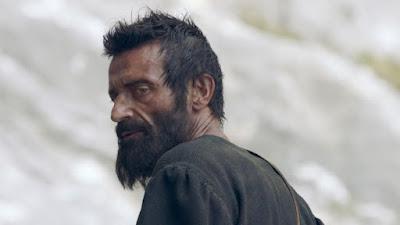
Alberto Testone, a dentist in real life, who resembles
Michelangelo, plays the lead part in the film
It is therefore important to know some basic details about Konchalovsky and Kiseleva in order to appreciate Sin, the film, in its totality.
Andrei Konchalovsky has been overlooked by many film critics and cinephiles for his outstanding contribution to the medium over several decades. As a Russian, the western world ignored him, possibly because his films were either not easily accessible nor well assessed by prominent western film critics. Most Tarkovsky fans do not realize that three of Tarkovsky’s early films (Andrei Rublev, Ivan’s Childhood, and The Steamroller and the Violin) were co-scripted by Konchalovsky (who incidentally was Tarkovsky’s classmate at film school). While Konchalovsky made a mark collaborating first with Tarkovsky, he later improved his credibility of his own worth by moving from scriptwriting to direction (five films he directed: Asya; The First Teacher; A Nest of the Gentry; Siberiade; and a superb film version of Uncle Vanya) in Russia during his pre-Hollywood phase, which saw these films winning a Golden Lion award at Venice film festival (for Asya), a Silver Lion for Best Actress at Venice (for The First Teacher), and the Grand Prize of the Jury at the Cannes festival (for Siberiade).
When he left Russia in 1980 to make films in Hollywood, one of his films (Runaway Train) got nominated for an Oscar and the Golden Palm at the Cannes film festival; another (Duet for One) got nominated for a Golden Globe; another (Maria’s Lovers) got nominated for the Golden Lion at the Venice film festival; another (Homer and Eddie) won the Golden Seashell for the best film at the San Sebastian Film Festival in Spain, while yet another of his films from his Hollywood period (Shy People) won the Best Actress award for Barbara Hershey at Cannes. These accolades strung together are more impressive global honors than the works of most other directors working in Hollywood and would make any one of them envious.
After he returned to Russia, disillusioned with the Hollywood studio system disagreeing with his artistic non-commercial concepts and eventually ending up being fired midway while trying to make Tango and Cash the way he conceived it, Konchalovsky struck gold by teaming up with co-scriptwriter Elena Kiseleva. His four films with her have won even better accolades than ever before in his career—The Postman’s White Nights (2014, Silver Lion For Best Director at Venice film festival); Paradise (2016, Silver Lion For Best Director at Venice film festival 2017, once again; Best Actor (Actress) award at the Munich film Festival,2017); Sin (2019, Best Cinematography, Best Production Design and Best Costume Design at the Nika awards, 2020); and Dear Comrades (2020, Special Jury Prize at the Venice film festival, Best Director at the Chicago international film festival, Best Film, Best Director, Best Actress, and Best Sound awards at the Nika awards). The magic weaved by the duo is comparable to the similar director-scriptwriter magic woven by Kieslowski and Piesiewicz in Poland, by Loach and Laverty, by Lean and Bolt, and by Losey and Pinter in UK-- all fine examples of directors peaking at the evening of their careers by teaming up with the right co-scriptwriter. The more you know of Konchalovsky's films you realize the director is a thinker and immensely well read compared to his peers globally and can arguably be only compared to Orson Welles or Raul Ruiz, not even Andrei Tarkovsky or Ingmar Bergman.
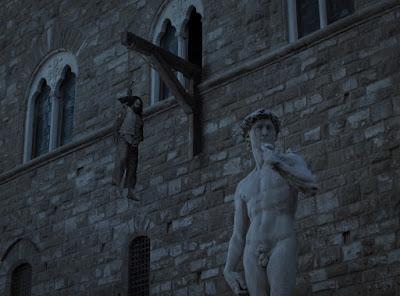
A Joycean epiphany perceived by Michelangelo woken up from slumber
at dawn in Florence. His statue of David is erected in the streets
but behind it is a man who has been hanged.
Konchalovsky vision of Michelangelo's quatrain
"..in this age of crime and shame/not to live, not to feel-an enviable destiny/
it is gratifying to sleep/ it is more gratifying to be stone"
Konchalovsky’s initial interest in making a film about the Italian artistic genius Michelangelo has an amazing connection with Andrei Rublev, which he co-scripted with Tarkovsky. This writer stumbled upon journalist/critic Valery Kichin’s revealing interview in Russian with Konchalovsky in 2018, in which Konchalovsky recalls noticing visitors to an Italian cathedral kissing a laminated A4-size Rublev’s painting called Trinity, ignoring the luxurious Italian frescoes in the vicinity. That incident sparked off the idea in Konchalovsky's mind of making a film on Michelangelo since his script on Rublev had struck gold nearly half a century earlier.
The well-read Konchalovsky recalled that Michelangelo in a response to a historian and aristrocrat Giovann Strozzi (who had written a quatrain admiring Michelangelo’s sculpture Night with the words “…she was sculpted from stone by an angel/if he sleeps then he is full of life/just wake up/ he will talk to you” to which Michelangelo had replied to Strozzi with a witty quatrain “Be quiet please, don’t you dare wake me/oh, in this age of crime and shame/not to live, not to feel-an enviable destiny/it is gratifying to sleep/ it is more gratifying to be stone.”
Konchalovsky connects that response of Michelangelo with why he decided to make Sin. He reveals to Kichin: “’In a shameful age I want to be stone.’ What did he mean by that about his life? ..If this statement is taken as an analysis of his life, an artist and a person? More precisely a person…An artist sculpts something from stone, writes notes, paints,..all this is in external form something secondary. There is a great play on Salieri’s envy of a genius (Mozart) but not about how the genius writes music. Michelangelo lives in the center of European culture, in Florence, and it so happens that he is brilliantly gifted. Hence, the theme and the conflict of my movie Sin. Michelangelo was a fan of Dante. Michelangelo in his sculptures expressed the idea of martyrdom, created images that were equal in expression to the images of Dante ” (Ref: https://rg.ru/2018/10/24/andrej-konchalovskij-moj-film-eto-moe-videnie-zhizni-mikelandzhelo.html)
In the same interview with Kichin, Konchalovsky reveals that even Leonardo da Vinci regarded Michelangelo as an expert on Dante’s writings and would refer him as such to Leonardo’s students. “Dante wrote in the genre of “visione”—using religious phantasmogoric visions” says Konchalovsky, who researched Michelangelo’s life for some 10 years before Sin was made.

The repentant Michelangelo in conversation with Dante (in red),
after he finds the newly married couple,
whose marriage he had financially supported
inexplicably killed and...
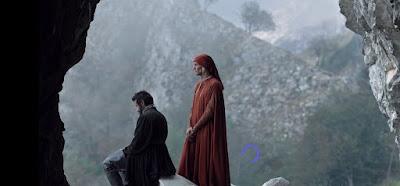
... the conversation with Dante continues, edited and transported
from the room to the mountains, with their positions unchanged.
"I know my creations are beautiful. People admire
them but nobody prays in front of them"
Thus, the differences between Carol Reed’s film The Agony and The Ecstasy (based on Irving Stone’s novel of the same name) made in 1965 and Michelangelo’s Sin are considerable. The former is an adaptation of a novel, while the latter is based on the director’s personal research. Konchalovsky’s film emphasizes the connections with Dante, which is not discussed by Reed and Stone. Reed’s film delves more on the Sistine Chapel paintings, while Konchalovsky’s film begins with the near completion of the Sistine Chapel paintings and is devoted more to Michelangelo working on later sculptures of Michelangelo, with the statue of David already erected on a street, in a dream sequence. And unlike Reed’s film where Contessina de Medici (played by Diane Cilento) is a major female personality close to Michelangelo, Konchalovsky’s film presents a hermit-like Michelangelo whose interest in women is clinical, to use visible aspects of their bodies as mere sources of inspiration for his sculptures and not sexual attraction.
Konchalovsky’s and Kiseleva’s original screenplay projects Michelangelo’s growing popularity with the rich and the poor alike as a maestro while he was still alive which led him to an artistic hubris, understandably with three Popes in succession asking Michelangelo to work for them when they became Popes: Pope Julius II (belonging to the Della Rovere family) and Popes Clemens VII and Paul III (belonging to the Medici family). Michelangelo had only contempt for his contemporary artist Raphael’s abilities (shown in Sin) unlike Raphael, who in admiration of Michelangelo, drew the portrait of Michelangelo as Heraclitus, a pre-Socratic Greek philosopher in one of his paintings for the Pope’s apartments. That pride of Michelangelo is the “arrogance” stated in one of the spoken lines in Sin. He did not allow even allow his assistants to work on his paintings and sculptures.
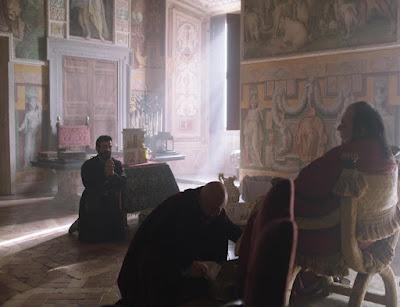
Michelangelo negotiates with one of the successive Popes
on assignments, payments and deadlines
In one of the memorable sequences in Sin, another painter is asked by the Pope to undertake a sculpture and design assignment that Michelangelo was initially asked to do and discusses the project with Michelangelo to gain some insights in a pub. In a nod to Dante’s Inferno in The Divine Comedy, while the Michelangelo and the other painter discuss the project, Michelangelo sees a reptile/snake in a pile of clothes in a corner. He goes to the pile to investigate and finds no snake. He returns to the table and tears up the design of the other painter. That’s another sin (envy) in the proximity of the devil (read, snake). Greed, pride and anger overtake Michelangelo, becoming richer by the day but living like hermit in tattered clothes on salted cod fish and forcing his apprentices to eat likewise. He began to imagine he was being poisoned when that was not true. An inexplicable murder of a bridal couple (married with the finances that Michelangelo provided) with their blood dripping on his table wakes up Michelangelo from slumber to acknowledge his sins of greed, pride and anger with Michelangelo asking forgiveness from God and seeking help from the long dead Dante Alighieri.
The Konchalovsky-Kiseleva duo extends the realistically unreal “purgatory” interview in their earlier award-winning work Paradise to insert several Joyce-like epiphanies of Michelangelo in the course of the film, with a final meeting with the dead Dante, who when asked for help, replies with single word “Listen” in response.
The interview with Kichin provides more fascinating insights. Konchalovsky began to see the finished collaborative script of Sin as an extension Andrei Rublev, there with a bell, here with a large chunk of marble. The 10-ton marble block in the film was transported with the help of 50 odd descendants of Carrara workers who speak the local dialect (of Michelangelo’s time) who extract marble to this day and was transported with oxen brought from different parts of Italy—not unlike Herzog making his Fitzcarraldo, transporting a steamship over hills of Peru. The actor Alberto Testone, chosen to play Michelangelo, is a dentist in real life and resembles Michelangelo (unlike Charlton Heston in Reed’s film) and gives a very impressive performance. But Konchalovsky has a knack to make his actors give outstanding performances (Barbara Hershey in Shy People, Julie Andrews in Duet for One, Jon Voight in Runaway Train, and, last but not least, his own wife Yulia Vysotskaya in Paradise and Dear Comrades).
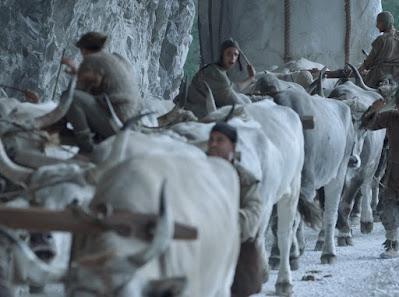
Transporting the 10-ton marble block from Carrera mountains to
the city reminiscent of Herzog's Fitzcarraldo
One wonders if Dante’s Divine Comedy, which is divided into three sections Inferno, Purgatory, and Paradise, fits well with a possible completed Konchalovsky trilogy made up with Sin and Paradise as being possible components with a possible third film being conceptualized. That said, Konchalovsky is one of the best filmmakers actively making award winning films over several decades and continues to work with some of the original team that worked with Tarkovsky such as Eduard Artemyev who composed and arranged music for most films of directors Tarkovsky, Konchalovsky and Konchalovsky’s half-brother Nikita Mikhalkov. The film is a treat for students of cinema, of the Bible, of the arts and of literature.
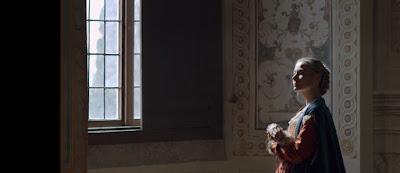
A silent cameo of Mrs Konchalovsky (actress Yulia Vyotskaya)
in Sin
P.S. A first cut of Sin was personally presented by President Putin of Russia to Pope Francis at the suggestion of Konchalovsky. It won Nika awards for cinematography, production design, and costume design. Several of Konchalovsky’s earlier films Runaway Train (1985), Shy People (1987), House of Fools (2002), The Postman’s White Nights (2014), and Paradise (2016) have been reviewed on this blog earlier (Please click on their names in this post-script to access those reviews)

